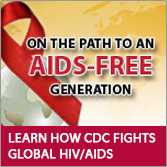Dominican Republic
HIV/AIDS in Dominican Republic
- 0.7% Estimated Prevalence
(Age 15–49) (2013) - 1,700 Estimated Deaths (2013)
- N/A Estimated Orphans
- 21,138 Reported Number of Adults Receiving ART (2012)
- 78% Estimated ART Coverage per WHO 2010 Guidelines (2012)
SOURCE: UNAIDS

Strategic Focus
CDC-Dominican Republic has three main HIV/AIDS-related goals: 1) Increase detection, access to care, and retention of people living with HIV to reduce AIDS-related mortality and HIV transmission, 2) Improve the quality of care for people living with HIV who are seen at public health clinics, and 3) Increase access to, and uptake of, HIV testing and counseling, condoms, and other evidence-based interventions for key populations. To achieve these goals, CDC works closely with the Ministry of Health and non-governmental partners to implement epidemiology and surveillance programs and to strengthen laboratory systems.
Epidemiology and Surveillance
CDC works with the Ministry of Health on several surveillance projects, including a national electronic surveillance system for reportable diseases, an electronic tuberculosis reporting system, a monitoring system for patients receiving treatment for HIV/AIDS, and sentinel surveillance for sexually transmitted infections. CDC also collaborates on several large population surveys to characterize the HIV/AIDS epidemic and trains health professionals in field epidemiology.
Laboratory Systems
The core of CDC-Dominican Republic’s laboratory systems strengthening is the Stepwise Laboratory Improvement Program Towards Accreditation (SLIPTA), developed by CDC and WHO/AFRO in 2009. Implemented at 20 national and regional laboratories since 2011, CDC-Dominican Republic also helped Central and Latin America introduce SLIPTA into their regions. It has been highly successful, empowering the Ministries to adopt a laboratory systems strengthening program into their institutional strategies.
HIV Prevention Services
CDC supports community-based and hospital-based HIV prevention programs. Community HIV prevention interventions focus on men-who-have-sex-with-men, people who inject drugs, and mobile populations (construction workers, agricultural workers, street vendors, and truck drivers).
Hospital-based programs include strengthening prevention of mother-to-child transmission services in 16 key hospitals that account for approximately 80% of all births in the country. Increasing blood safety is being achieved through a national voluntary donation strategy, and a quality management system was implemented at eight regional blood banks.
Key Activities and Accomplishments
Helped the Ministry of Health implement a national strategy for the prevention of mother-to-child transmission of HIV and syphilis
SLIPTA enrolled laboratories have decreased turnaround time for HIV results of pregnant women from several days to two hours
Conducted HIV prevention interventions among men-who-have-sex-with-men, drug users, and mobile populations
Supported field epidemiology training at basic, intermediate, and advanced levels
Supported monitoring and evaluation training for health programs
Contact Us:
- Centers for Disease Control and Prevention
1600 Clifton Rd
Atlanta, GA 30333 - 800-CDC-INFO
(800-232-4636)
TTY: (888) 232-6348
24 Hours/Every Day - cdcinfo@cdc.gov
 ShareCompartir
ShareCompartir



